
Minerals and rocks are stable only under the conditions at which they form. Change the conditions and the rocks will change to adapt to the new conditions.
The principle is obvious if we raise the temperature a couple of thousand degrees; rocks melt and form magma (liquid rock), which then cools and crystallizes to form igneous rocks. These and other processes of transformation are the rationale for the rock cycle that says all rocks can be transformed into other rocks (rock cycle discussion).
Yet, if that granite is left out, laying on the ground, it will decompose (weather) into something new that is stable under earth surface conditions, and it will do this just as surely as it will melt if we raise the temperature high enough. Of course, if you were to wait around for this to happen you would wait a long time, by human standards. But in a geologically short time, a few tens or hundreds of thousands of years, the granite will alter into minerals stable at, in equilibrium with, the conditions at the earth's surface.
For example, the three pictures below are of a coarse grained granite with pink orthoclase feldspar (similar to, but not the same specimen as above right). They all came from the same locality. Click on picture for larger images, or see other examples.
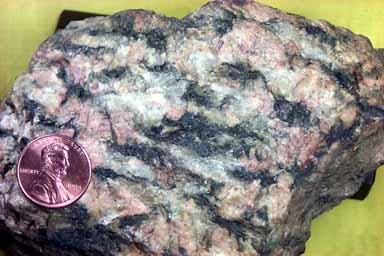 The sample on the left is one that is almost pristine, with little weathering. Notice the pink orthoclase, black amphibole, and clear glassy quartz. All these are hard, durable minerals, bright and shiny. Note especially the pinkness of the orthoclase.
The sample on the left is one that is almost pristine, with little weathering. Notice the pink orthoclase, black amphibole, and clear glassy quartz. All these are hard, durable minerals, bright and shiny. Note especially the pinkness of the orthoclase. 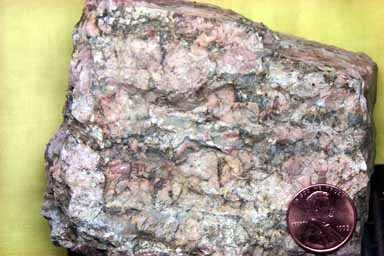 This second picture is the same granite, but one that has begun to weather; notice how the luster of the orthoclase has become dull, and the color has begun to fade.
This second picture is the same granite, but one that has begun to weather; notice how the luster of the orthoclase has become dull, and the color has begun to fade. In the third picture the granite has crumbled into a pile of decomposing igneous minerals, and their weathering products - clay, and other new sedimentary minerals. Such weathered material is grus, and is commonly found at the base of granite slopes. Soon it will be picked up by rain, streams, and rivers, and begin it journey to the sea, and deposited to become a sedimentary rock.
In the third picture the granite has crumbled into a pile of decomposing igneous minerals, and their weathering products - clay, and other new sedimentary minerals. Such weathered material is grus, and is commonly found at the base of granite slopes. Soon it will be picked up by rain, streams, and rivers, and begin it journey to the sea, and deposited to become a sedimentary rock.To understand sedimentary rocks we need a model that strips sedimentary rocks down to their quintessence - that is, the things that are most essentially true and necessary about sedimentary rocks, without any of the details - a simple, ideal model.
The Simple Ideal Model
For Understanding Sedimentary Rocks
The key to understanding sedimentary rocks is to realize that all sedimentary processes of weathering, transportation, and deposition are aimed at one goal - reaching the three final end products of all sedimentary processes, quartz sand, shale (clay), and limestone (CaCO3). The central idea is summarized in the SIMPLE, IDEAL MODEL. {full page html version; pdf version for printing} (What's pdf ?) 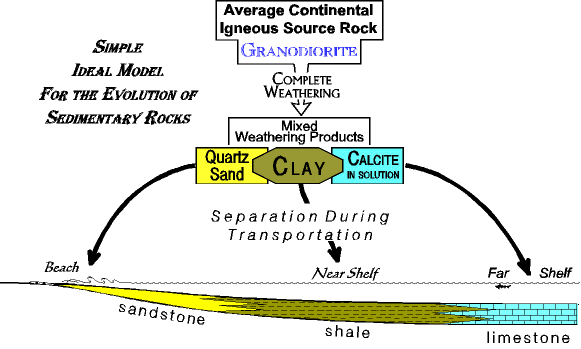
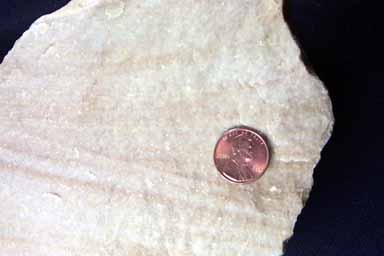 Quartz sandstone |
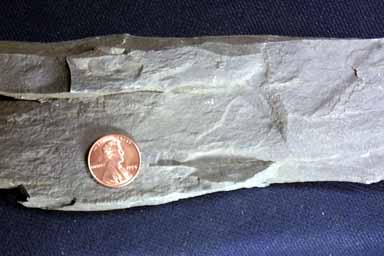 Shelf shale |
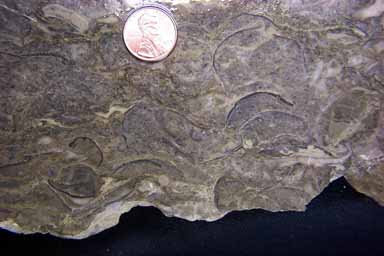 Limestone with fossils |
| OBSERVE: A source of confusion is the switch from mineral names to rock names. Clay is a mineral that forms from the weathering of feldspars such as orthoclase. Clay is extremely fine grained; it is the mud on your shoes, or the mud (suspended clay) in a river or pond. When clay is deposited it becomes the rock shale Calcite is a mineral with rhombohedral cleavage that reacts with dilute hydrochloric acid. As a sedimentary mineral it exists either as micrite ("lime mud", that is as fine grained as clay) or large pieces such as animal skeletons. These together form the rock limestone. Quartz sand is, or course, just quartz sand. It is released as grains from the parent rock by weathering, and after that is little changed. |
Now imagine we are going to do every sedimentary process to that rock that it is possible to do, including complete weathering, and complete transportation, sorting and deposition. The results are always the same - quartz sandstone, shale, and limestone separated from each other in different depositional environments: the beach, near shelf, and far self.
Model Processes
.
Sedimentary systems work this way because of two processes. WEATHERING: Weathering is the breakdown of one mineral/rock into another. Of the eight igneous rock forming minerals all are subject to degradation (weathering into something else), except quartz. Quartz, for all intents and purposes, does not weather and will survive in the system relatively unscathed.
The remaining seven rock forming minerals all dissolve to make the sea salty, or decompose to form new minerals stable at the earth's surface. Orthoclase, for example, breaks down to form clay, and the calcium in Ca plagioclase goes into solution to form CaCO3. There are lots of other weathering products, of course, but they are just details. The simple, ideal model predicts three end products, quartz sand, shale, and limestone, which all together compose the vast majority of sedimentary rocks.
TRANSPORTATION AND SORTING:
The result is, during transportation these three weathering products do not transport equally well, and become separated. The final separation takes place at the ocean shoreline (image to right). Here we see river transported sediment entering the ocean. Waves crashing on the beach keep the sediment continuously stirred up. The quartz, being relatively heavy, settles quickly to the bottom, the clay remains in suspension until it drifts to the quieter near shelf, where if finally settles to the bottom to form shale.

Sedimentary Attractors
.
An attractor is any state toward which a system naturally evolves.
Someone who is an attractive person (by temperament as well as physically) is an attractor toward whom we are naturally drawn. Biological fitness is an attractor toward which species evolve. A valley surrounding a hilly landscape is an attractor. A ball placed anywhere in the landscape will roll down the hill toward the valley. It doesn't matter where the ball starts or how fast it is rolling, it eventually ends up at the bottom of the valley - the attractor. (The attractor is actually gravity since if the ball had its druthers, and the opportunity, it would fall to the center of the earth, the center of gravity.)
In the sedimentary model quartz sandstone, shale, and limestone can be thought of as "attractors." All the processes in the sedimentary system are "attracted" to these three end products. And this is true regardless of what you start with.
The simple, ideal model begins with a granodiorite, but any source rock has the same three attractors, and this is true even if the components to make one of the attractors is not present in the source rock. For example, a source rock with no quartz cannot produce a sediment with quartz, but that does not take away from the fact that quartz is an attractor in the system.
Sandstone Maturity
Sandstone study is particularly important, not only because sandstones are common, but also because they contain a lot of information. Near the sourceland sandstone contain lots of incompletely weathered minerals and rock fragments. The more the sand transports the more these weatherable components transform into clay and dissolved minerals (e.g. calcite), leaving behind more and more quartz as the only remaining, unweathered sand grains. At the end, then, all the rock forming minerals transform into other sedimentary minerals, except quartz.Sandstone composition is thus a measure of how close a sandstone has gotten to the quartz attractor - the end product of the simple ideal model. This leads to the concept of maturity.
MATURITY - a relative measure of how extensively and thoroughly a sediment (sand size and larger) has been weathered, transported and reworked toward its ultimate end product, quartz sand.
The definition of maturity makes it clear that our interest in sedimentary rocks is in their evolution, and ultimately we want a classification that allows us to explore that evolution. The simple ideal model can be achieved, however, only in a region that is tectonically stable (tectonics has to do with earth movement, and the structures that result). For example, Stage A and Stage I of the Wilson Cycle. The simple ideal model is what tectonic stability gives you, and is about the only place that limestones are deposited.
But tectonic stability is boring. Most clastic sedimentary rocks (i.e. sandstones and shales), begin their history in an area of tectonic instability, a region of mountain building, such as Stage E or Stage F of the Wilson Cycle.
Thus, achieving the three sedimentary attractors of the simple ideal model is not easy, and completely mature sandstones are not that common. To more fully understand sedimentary rocks we have to examine in more detail each of the processes of weathering, and transportation.
|
Go on to: |
Print Versions of Model |